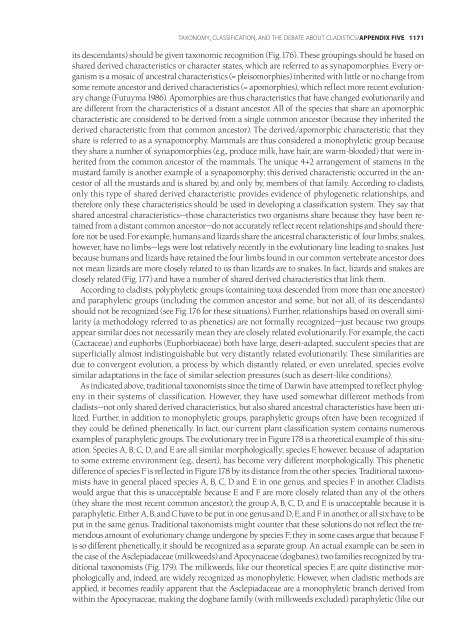Appendices & Glossary - Botanical Research Institute of Texas
Appendices & Glossary - Botanical Research Institute of Texas
Appendices & Glossary - Botanical Research Institute of Texas
Create successful ePaper yourself
Turn your PDF publications into a flip-book with our unique Google optimized e-Paper software.
TAXONOMY, CLASSIFICATION, AND THE DEBATE ABOUT CLADISTICS/APPENDIX FIVE<br />
1171<br />
its descendants) should be given taxonomic recognition (Fig. 176). These groupings should be based on<br />
shared derived characteristics or character states, which are referred to as synapomorphies. Every organism<br />
is a mosaic <strong>of</strong> ancestral characteristics (= pleisomorphies) inherited with little or no change from<br />
some remote ancestor and derived characteristics (= apomorphies), which reflect more recent evolutionary<br />
change (Futuyma 1986). Apomorphies are thus characteristics that have changed evolutionarily and<br />
are different from the characteristics <strong>of</strong> a distant ancestor. All <strong>of</strong> the species that share an apomorphic<br />
characteristic are considered to be derived from a single common ancestor (because they inherited the<br />
derived characteristic from that common ancestor). The derived/apomorphic characteristic that they<br />
share is referred to as a synapomorphy. Mammals are thus considered a monophyletic group because<br />
they share a number <strong>of</strong> synapomorphies (e.g., produce milk, have hair, are warm-blooded) that were inherited<br />
from the common ancestor <strong>of</strong> the mammals. The unique 4+2 arrangement <strong>of</strong> stamens in the<br />
mustard family is another example <strong>of</strong> a synapomorphy; this derived characteristic occurred in the ancestor<br />
<strong>of</strong> all the mustards and is shared by, and only by, members <strong>of</strong> that family. According to cladists,<br />
only this type <strong>of</strong> shared derived characteristic provides evidence <strong>of</strong> phylogenetic relationships, and<br />
therefore only these characteristics should be used in developing a classification system. They say that<br />
shared ancestral characteristics—those characteristics two organisms share because they have been retained<br />
from a distant common ancestor—do not accurately reflect recent relationships and should therefore<br />
not be used. For example, humans and lizards share the ancestral characteristic <strong>of</strong> four limbs; snakes,<br />
however, have no limbs—legs were lost relatively recently in the evolutionary line leading to snakes. Just<br />
because humans and lizards have retained the four limbs found in our common vertebrate ancestor does<br />
not mean lizards are more closely related to us than lizards are to snakes. In fact, lizards and snakes are<br />
closely related (Fig. 177) and have a number <strong>of</strong> shared derived characteristics that link them.<br />
According to cladists, polyphyletic groups (containing taxa descended from more than one ancestor)<br />
and paraphyletic groups (including the common ancestor and some, but not all, <strong>of</strong> its descendants)<br />
should not be recognized (see Fig. 176 for these situations). Further, relationships based on overall similarity<br />
(a methodology referred to as phenetics) are not formally recognized—just because two groups<br />
appear similar does not necessarily mean they are closely related evolutionarily. For example, the cacti<br />
(Cactaceae) and euphorbs (Euphorbiaceae) both have large, desert-adapted, succulent species that are<br />
superficially almost indistinguishable but very distantly related evolutionarily. These similarities are<br />
due to convergent evolution, a process by which distantly related, or even unrelated, species evolve<br />
similar adaptations in the face <strong>of</strong> similar selection pressures (such as desert-like conditions).<br />
As indicated above, traditional taxonomists since the time <strong>of</strong> Darwin have attempted to reflect phylogeny<br />
in their systems <strong>of</strong> classification. However, they have used somewhat different methods from<br />
cladists—not only shared derived characteristics, but also shared ancestral characteristics have been utilized.<br />
Further, in addition to monophyletic groups, paraphyletic groups <strong>of</strong>ten have been recognized if<br />
they could be defined phenetically. In fact, our current plant classification system contains numerous<br />
examples <strong>of</strong> paraphyletic groups. The evolutionary tree in Figure 178 is a theoretical example <strong>of</strong> this situation.<br />
Species A, B, C, D, and E are all similar morphologically; species F, however, because <strong>of</strong> adaptation<br />
to some extreme environment (e.g., desert), has become very different morphologically. This phenetic<br />
difference <strong>of</strong> species F is reflected in Figure 178 by its distance from the other species. Traditional taxonomists<br />
have in general placed species A, B, C, D and E in one genus, and species F in another. Cladists<br />
would argue that this is unacceptable because E and F are more closely related than any <strong>of</strong> the others<br />
(they share the most recent common ancestor); the group A, B, C, D, and E is unacceptable because it is<br />
paraphyletic. Either A, B, and C have to be put in one genus and D, E, and F in another, or all six have to be<br />
put in the same genus. Traditional taxonomists might counter that these solutions do not reflect the tremendous<br />
amount <strong>of</strong> evolutionary change undergone by species F; they in some cases argue that because F<br />
is so different phenetically, it should be recognized as a separate group. An actual example can be seen in<br />
the case <strong>of</strong> the Asclepiadaceae (milkweeds) and Apocynaceae (dogbanes), two families recognized by traditional<br />
taxonomists (Fig. 179). The milkweeds, like our theoretical species F, are quite distinctive morphologically<br />
and, indeed, are widely recognized as monophyletic. However, when cladistic methods are<br />
applied, it becomes readily apparent that the Asclepiadaceae are a monophyletic branch derived from<br />
within the Apocynaceae, making the dogbane family (with milkweeds excluded) paraphyletic (like our
















